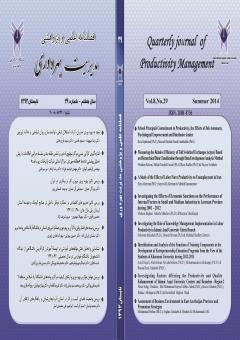A Study of the Effect of Labor Force Productivity on Unemployment in Iran
Subject Areas : Business ManagementRoya Alomran 1 , Seyed Ali Alomran 2 , Vahide Kasmaye pour 3
1 - Assistant Professor, Islamic Azad University, Tabriz Branch, Economics Department, Tabriz, Iran
2 - Ph.D. Student, Urban and Regional Economics, Tabriz University, Tabriz, Iran
3 - Graduate Student, Islamic Azad University, Tabriz Branch, Department of Economics, Tabriz, Iran
Keywords: J24, Unemployment, Productivity of labor, Ordinary Least Squares JEL Classification: J60, C10,
Abstract :
Unemployment is classified as one of the most serious obstacles to economic and social progress. So to avoid the negative effects of unemployment, reducing the rate of unemployment should be considered as one of the leading development goals in developing countries. One characteristic of developing countries is the low rate of productivity growth, and the increase in productivity is the result of reducing the use of resources, reducing costs, using better methods of production or improving the ability of production factors, especially the labor-force. So, the Objective of this research is to study the effect of productivity of labor-force on unemployment in Iran from 1978 to 2010. For the theoretical analysis of the topic, ordinary least squares method was used, and the data were collected by the annual time series coefficients data. The research results of this method indicate that the impact of all variable coefficients has been expected based on the theoretical frame work, the coefficients for all variables are significant, and productivity of labor has a negative effect on unemployment.
Beheshti, M. B., Khayavar, M. H., & Qazvinian, M. H. (2009). Study of the Relation Between Entrepreneurship and Unemployment in Iran's Industrial Sector. Beyond Management, 183-157, (In Persian).
Chiarini, Bruno and Piselli (2005), Business Cycle, Unemployment Benefits and Productivity Shocks, Journal of Macroeconomics, Vol.27, PP: 670-690.
Fallahi, M. A., Hosseinzadeh Bahreini, M. H., & Moghaddamnejad, H. (2012). The Relationship between Productivity and Employment Changes in Iran's Industry (Application of the Blenchard-Cove Analysis Method). Journal of Research on Growth and Economic Development, 8, pp. 23-36, (In Persian).
Gallegati, Marco and Gallegati, Mauro and Ramsey, James B. and Semmler, Willi (2011), Productivity and Unemployment Scale-by-Scale Relationship, available at: www.google.com
Jalaei, S. A., & Shirafakan, M. (2009). The Effect of Monetary Policies on the Execution Level by Analyzing the Phillips New-Keynesian Curve in Iran. Economic Sciences Journal, 2, 13-36, (In Persian).
Minqi, Li (2004), Aggregate Demand, Productivity and Disguised Unemployment in the Chinese Industrial Sector, World Development, Vol. 32, No.3, PP: 409-425.
Mosaee, M., & Garshasbi-Fakhr, S. (2010). The Study of the Relationship between Unemployment and Trafficking in Narcotic Drugs in Iran. Social Issues, 7, pp. 145-167, (In Persian).
Najar Nahavandi, M., & Khaki, A. (2009). Demographic Analysis of Unemployment in Active Population in Different Provinces of the Country Based on the 2006 Census. Journal of Iranian Demography Institute, 7, 115-139, (In Persian).
Okudaira, Hiroko and Takizawa, Miho and Tsuru, Kotaro (2011), Employlent Protection and Productivity: Evidence from Firm-Level Panel Data in Japan, RIETI Discussion Paper Series 11-E-078.
Qavidel, S. (2008). Self-Employment in Unemployment (Case of Iran). Journal of Economic Research, 1, 21-41, (In Persian).
Razini, E. A., Suri, A. R., & Hosseini, A. (2011). Unemployment and Government Measure: Is There An Existing Relationship?. Quarterly Journal of Economic Research, 2, 35-57, (In Persian).
Samty, M., & Albusovillem, M. (2009). The Impact of Participation Rate and Unemployment Rate on the Underground Economies in OECD Countries. Quantitative Economics Quarterly, 2, 63-88, (In Persian).
Shahabadi, A., & Khani, Z. (2012). Investigating the Relation Between the Efficiency of Total Factors and the Unemployment Rate in Iran's Economy. Journal of Economic Growth and Development Researches, 17, 35-58, (In Persian).
_||_
Beheshti, M. B., Khayavar, M. H., & Qazvinian, M. H. (2009). Study of the Relation Between Entrepreneurship and Unemployment in Iran's Industrial Sector. Beyond Management, 183-157, (In Persian).
Chiarini, Bruno and Piselli (2005), Business Cycle, Unemployment Benefits and Productivity Shocks, Journal of Macroeconomics, Vol.27, PP: 670-690.
Fallahi, M. A., Hosseinzadeh Bahreini, M. H., & Moghaddamnejad, H. (2012). The Relationship between Productivity and Employment Changes in Iran's Industry (Application of the Blenchard-Cove Analysis Method). Journal of Research on Growth and Economic Development, 8, pp. 23-36, (In Persian).
Gallegati, Marco and Gallegati, Mauro and Ramsey, James B. and Semmler, Willi (2011), Productivity and Unemployment Scale-by-Scale Relationship, available at: www.google.com
Jalaei, S. A., & Shirafakan, M. (2009). The Effect of Monetary Policies on the Execution Level by Analyzing the Phillips New-Keynesian Curve in Iran. Economic Sciences Journal, 2, 13-36, (In Persian).
Minqi, Li (2004), Aggregate Demand, Productivity and Disguised Unemployment in the Chinese Industrial Sector, World Development, Vol. 32, No.3, PP: 409-425.
Mosaee, M., & Garshasbi-Fakhr, S. (2010). The Study of the Relationship between Unemployment and Trafficking in Narcotic Drugs in Iran. Social Issues, 7, pp. 145-167, (In Persian).
Najar Nahavandi, M., & Khaki, A. (2009). Demographic Analysis of Unemployment in Active Population in Different Provinces of the Country Based on the 2006 Census. Journal of Iranian Demography Institute, 7, 115-139, (In Persian).
Okudaira, Hiroko and Takizawa, Miho and Tsuru, Kotaro (2011), Employlent Protection and Productivity: Evidence from Firm-Level Panel Data in Japan, RIETI Discussion Paper Series 11-E-078.
Qavidel, S. (2008). Self-Employment in Unemployment (Case of Iran). Journal of Economic Research, 1, 21-41, (In Persian).
Razini, E. A., Suri, A. R., & Hosseini, A. (2011). Unemployment and Government Measure: Is There An Existing Relationship?. Quarterly Journal of Economic Research, 2, 35-57, (In Persian).
Samty, M., & Albusovillem, M. (2009). The Impact of Participation Rate and Unemployment Rate on the Underground Economies in OECD Countries. Quantitative Economics Quarterly, 2, 63-88, (In Persian).
Shahabadi, A., & Khani, Z. (2012). Investigating the Relation Between the Efficiency of Total Factors and the Unemployment Rate in Iran's Economy. Journal of Economic Growth and Development Researches, 17, 35-58, (In Persian).


